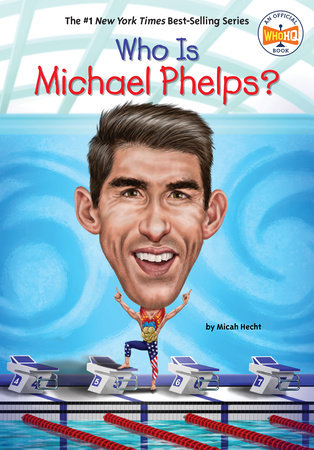Excerpt
Who Is Michael Phelps?
Who Is Michael Phelps? On August 15, 2008, the world’s eyes were on one man in a swimming pool in Beijing, China. Every day of the 2008 Summer Olympics had been filled with excitement. But today, an American swimmer from Maryland was taking a step to become one of the greatest athletes in history.
Michael Phelps, who was twenty-three years old, stood behind lane five of the swimming pool. Reporters and athletes called the building the “Water Cube” because its walls and ceiling were made of glass panels that looked like bubbles. The view of the ceiling made you feel like you were underwater! So far that week, Michael had swum six other Olympic final races. He had finished each of those races faster than the other swimmers, taking home six gold medals. If he could win seven gold medals, he would tie former professional swimmer Mark Spitz as the athlete to win the most gold medals in one Olympics. If he could win eight gold medals, he would do something no one had ever done before!
Michael stepped onto the starting block. He bent at the hips, raised his arms back behind him, and let them fall down. His arms crossed his chest with a great slapping sound. That was his signature move. It was how Michael warmed up his muscles and let the competition know who they were up against. The arm-clap sound rang out once, twice, three times throughout the Water Cube.
“Take your marks.”
Michael took a step forward with his left foot and gripped his hands on the edge of the starting block.
Beep! The starting sound rang out. The swimmers dove into the pool. Michael could hear water whooshing by his ears. His arms were tight against his head in a streamlined dive position. He dolphin kicked to the surface. Then he started to swim the butterfly stroke. Both arms came up and over the water together, then dove back in to pull him forward.
A swimmer from Serbia was in the lane next to Michael. Before the race, the swimmer had told reporters that he wanted to beat Michael. “It would be nice if historians talk about Michael Phelps winning seven gold medals and losing the eighth to some guy. I’d like to be that guy,” the other swimmer had said.
Hearing this before the race made Michael want to win even more.
The race was the 100-meter butterfly. At the halfway mark, Michael saw his competitor was well ahead of him. Michael picked up speed through the second half. In the final two meters, he could see the other swimmer gliding into the wall. The other swimmer’s arms extended just inches from the end of the pool. In that split second, Michael had a decision to make: He could glide into the wall and finish second. Or he could take an extra half stroke and see if it could get him to the finish faster. Even the youngest swimmers can tell you that half strokes into the finish are usually too slow. But this was a special case.
To keep his dream alive, Michael brought his arms over his head one last time and touched the wall. He turned and looked at the scoreboard. Surely, he had lost the race.
1. Michael Phelps USA: 50.58
2. Milorad Cavic SRB: 50.59
He had won his seventh Olympic gold of the 2008 Summer Olympics by the smallest possible margin! He was now on his way to becoming the greatest Olympic athlete of all time!
Chapter 1 A Boy Full of Energy Michael Fred Phelps II was born on June 30, 1985, in Baltimore, Maryland. As a young child, Michael lived with his mother, father, and two older sisters in Towson, Maryland. His mother, Debbie, was a middle-school principal. His father, also named Michael but who was known as Fred, was a police officer.
As a kid, Michael loved causing mischief. If a parent or teacher told him not to do something, he had to try it! Michael wasn’t afraid to eat a big spoonful of spicy hot sauce, and he would play with his food, mixing it all together on his plate and pouring milk on top to make a soup.
Sitting still was the hardest thing for Michael to do. He always wanted to keep moving or fidgeting. His body just felt better when it was moving. Michael liked to twirl pens and pencils in between his middle fingers. Sometimes pens and pencils weren’t available, so he would try twirling whatever he could find! He loved climbing on things that were not meant for climbing.
He made funny faces whenever someone tried to take a picture of him. He wrestled with his friends. When adults asked him questions, he would answer with his own questions.
It wasn’t until Michael was nine years old that his mom took him to the doctor to figure out if they could help him. After speaking with Michael, a doctor diagnosed him with attention deficit hyperactivity disorder (ADHD). This is a medical condition that makes it difficult for some people to stay focused on a task or sit still. Today, kids and adults with ADHD can talk about the positive ways it affects their lives and personalities. They say that having ADHD is not good or bad. It’s just different.
However, in the 1980s and 1990s, people were more likely to think of ADHD as a bad thing. They thought there was only one “right” kind of brain. Some of Michael’s classmates and teachers were supportive of his uniqueness. His third-grade teacher told him that he had “an active personality.” She thought his fidgeting was healthy. Instead of telling Michael what to do, she asked him what
he wanted to do. But many adults and classmates in Michael’s life were not very kind to him because of his fidgeting. One elementary school teacher told Michael’s mom, “I just don’t ever see him being able to focus on anything in his life.”
Attention Deficit Hyperactivity Disorder (ADHD) Many kids sometimes have trouble sitting still, being patient, or listening. But children with ADHD deal with these issues all the time.
People with ADHD may also have boundless energy. Or they might have the ability to focus extra hard on the things they love. Or they may be very creative or courageous. Some people see ADHD as a disorder, like a disease. But more and more people with ADHD are starting to say that they do not have a disorder, they are just different.
Daily life can still be a struggle, though, for people with ADHD. Many schools, public places, and workplaces aren’t set up for people whose brains work differently. Sometimes medications can help kids and adults with ADHD focus more easily. Michael would also get picked on by bullies who would make fun of the way he spoke with a lisp or the size of his ears. Some kids would flick his ears or call him “Spock”—a pointy-eared character from the television show
Star Trek. Michael liked to wear hats to cover his ears and avoid being made fun of, but sometimes kids would grab his hat and throw it onto the street.
When Michael was in elementary school, two things happened that changed his life forever: He started swimming, and his parents got divorced. In 1994, Michael’s parents made the decision to end their marriage, and Michael’s father moved out of their family home. Michael couldn’t believe it. The divorce didn’t feel real for him until days later. Usually, Michael had to wait hours for his dad to be done with the computer so that he could play games. But one day after his dad moved out, Michael went to the computer and realized he didn’t have to wait anymore. His dad wasn’t coming back. Swimming was one way Michael dealt with his feelings about his parents’ divorce.
Years earlier, a doctor had told Debbie that children should learn how to swim for water safety, so she enrolled Michael’s older sisters, Hilary and Whitney, for swim lessons, and they later joined the swim team. Michael would hear their alarms going off at 4:00 a.m. for morning swim practice. Hilary and Whitney both became very accomplished swimmers.
When Michael was seven years old, it was his turn to get into the pool. Debbie decided that swimming might also be a good way for Michael to work off some of his boundless energy. At his first lesson, he hated the water. He was scared to get his face wet. He kicked and screamed. When that didn’t work, he asked to stop, saying he was tired and cold. “That’s your problem, Michael Phelps,” his swimming teacher said. “Your mom wants you to learn how to swim, so you’re going to swim.”
His teacher started off by teaching Michael how to float on his back. At least when he floated on his back, the water wasn’t in his face. After a few lessons, Michael started to get better at swimming. Then it wasn’t as scary to flip over and put his face into the water. Soon, he wanted to spend every free moment in the pool.














